Wai-Fah Chen.The Civil Engineering Handbook
Подождите немного. Документ загружается.


29-10 The Civil Engineering Handbook, Second Edition
mass, momentum, and energy may pass. The control volume plays the role of the free body in statics as a
device to organize and systematize the accounting of fluxes and forces. In the following, the fluid is assumed
to be of constant density, r, and the control volume is assumed fixed in space and non-deforming.
Fluxes and Correction Coefficients
The flux of a quantity, such as mass or momentum, across a control surface, S, is defined as the amount
that is transported across S per unit time. The mass flux,
•
m, is defined as an integral over the surface,
(29.8)
where the velocity, u, may vary over the control surface, the discharge or volume flow rate is Q = ,
and V is the average velocity over the area A.
The momentum flux can similarly be expressed as
(29.9)
The momentum correction factor, b, accounts for the variation of u over S, and is defined by Eq. (29.9).
If u is constant over S, then b = 1. The momentum flux, unlike the mass flux, is a vector quantity, and
is therefore associated with a direction as well as a magnitude. The mechanical energy flux can be expressed
as
(29.10)
The kinetic energy correction factor, a, accounts for variations in u across the control surface, and is
defined as
(29.11)
For fully developed turbulent flows in pipes and rectangular channels, b and a are generally close to
unity, but may deviate significantly from unity in a channel with a complicated cross-sectional geometry
or in separated flows.
The Conservation Equations
The law of conservation of mass, also termed mass balance or continuity, states that the change in time of
fluid mass in a control volume, cv, must be balanced by the sum of all mass fluxes crossing all control
surfaces:
(29.12)
where the integral is taken over the control volume, and the subscripts, in and out, refer to fluxes into
and out of the control volume.
For steady flow with one inlet and one outlet, Eq. (29.12) simplifies to
•
m
in
=
•
m
out
, and
(29. 13)
˙
mudSVA
S
∫ =
Ú
rr
u Sd
S
Ú
˙
m udS
S
brVu=
Ú
˙
mg z
V
g
z
u
g
udS
S
+
Ê
Ë
Á
ˆ
¯
˜
=+
Ê
Ë
Á
ˆ
¯
˜
Ú
ag
22
22
a=
Ê
Ë
Á
ˆ
¯
˜
Ú
1
3
A
u
V
dS
S
d
dt
dmmr
cv
in out
V
Ú
ÂÂ
=-
˙˙
QVA VA==
in in out out
© 2003 by CRC Press LLC

Fundamentals of Hydraulics 29-11
The law of conservation of momentum, based on Newton’s second law, states that the change in time
of fluid momentum in the control volume is equal to the sum of all momentum fluxes across all control
surfaces plus all forces, F, acting on the control volume:
(29.14)
For steady flow with one inlet and one outlet, Eq. (29.14) simplifies to
(29.15)
since
•
m =
•
m
in
=
•
m
out
because of mass conservation. In contrast to the mass conservation equation, the
momentum balance equation is a vector equation. Care must therefore be taken in considering different
components, and accounting for the directions of the individual terms. The analysis is identical to free-
body analysis of statics except that fluxes of momentum must also be considered in the force balance.
The law of conservation of energy, based on the first law of thermodynamics, states that the change in
time of the total energy of a system is equal to the rate of heat input minus the rate at which work is
being done by the system. For problems with negligible heat transfer, this can be usefully expressed in
terms of ‘fluxes’ of total head as:
, (29.16)
where the total head, H, is defined as
(29.17)
which is the sum of the piezometric head, (p/g) + z, and the velocity head, aV
2
/2g. While z and aV
2
/2g
are readily identified as energy components, arising from gravitational potential energy and kinetic energy
respectively, the pressure-work or flow-work term, p/g, measures the (reversible) work done by pressure
forces.
•
W
s
represents the shaft work, as in pumps and turbines, done by the system. The head loss, h
L
≥
0, represents the conversion of useful mechanical energy per unit weight of fluid into unrecoverable
internal or thermal energy. For the frequent case of a steady flow with a single inlet and a single outlet,
Eq. (29.16) becomes
(29.18a)
where
•
W
s
= –
•
W
p
+
•
W
t
, the rate of work done by the system on the pump is –
•
W
p
=–
•
mgH
p
, and the rate
of work done by the system on the turbine is
•
W
t
=
•
mgH
t
, H
p
and H
t
represent respectively the head per
unit weight of liquid delivered by a pump or lost to a turbine. In expanded form, this is often expressed as
(29.18b)
Because of its similarity to Eq. (29.7), the energy equation, Eq. (29.18), is often also termed loosely the
(generalized) Bernoulli equation.
d
dt
dm mrbbuV V V F
cv
in out
Ú
ÂÂ Â
=- +(
˙
)(
˙
)
˙
m bbVV F
()
-
()
[]
=
Â
out in
d
dt
u
gz d mgH mgH W mgh
sL
r
cv
in out
Ú
ÂÂ ÂÂ
+
Ê
Ë
Á
ˆ
¯
˜
=- --
2
2
V (
˙
)(
˙
)
˙
˙
H
p
z
V
g
∫ ++
g
a
2
2
HHH Hh
ptLin out
+= ++
p
z
V
g
H
p
z
V
g
Hh
ptL
g
a
g
a++
Ê
Ë
Á
ˆ
¯
˜
+=++
Ê
Ë
Á
ˆ
¯
˜
++
22
22
in out
,
© 2003 by CRC Press LLC
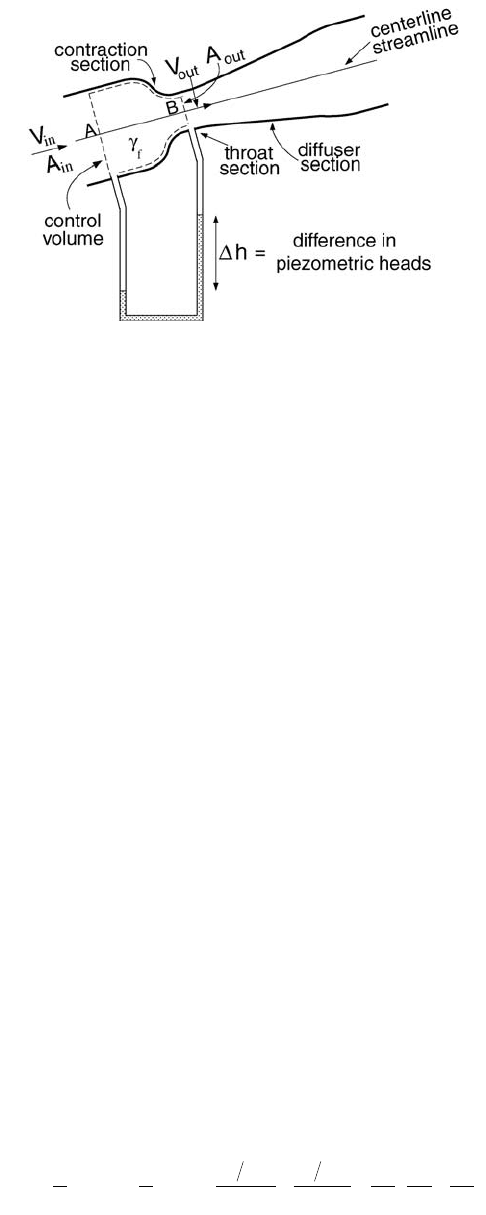
29-12 The Civil Engineering Handbook, Second Edition
Energy and Hydraulic Grade Lines
For the typical steady one-dimensional nearly horizontal flows, hydraulic and energy grade lines (HGL
and EGL, respectively) are useful as graphical representation of the piezometric and the total head
respectively. For flows in which frictional effects are neglected, the EGL is simply a horizontal line, since
the total head must remain constant. If frictional effects are considered, the EGL slopes downward in
the direction of flow because the total head, H, is reduced by frictional losses. The slope is termed the
friction or energy slope, denoted by S
f
= h
f
/L, where h
f
is the continuous head loss over a conduit of
length, L, due to boundary friction along pipe or channel boundaries. In pipe flows, S
f
is not related to
the pipe slope (in open-channel flows, however, for the special case of uniform flow, S
f
is equal to the
slope of the channel). The EGL rises only in the case of energy input, such as by a pump. For flows that
are uniform in the streamwise direction, the HGL runs parallel to the EGL because the velocity head is
constant. The HGL excludes the velocity head, and so lies at an elevation exactly aV
2
/2g below the EGL;
it coincides with the EGL only where the velocity head is negligible, such as in a reservoir or large tank.
Even without energy input or output, the HGL may rise or fall, due to a decrease or increase in flow area
leading to an increase or decrease in velocity head. The elevation of the HGL above the pipe centerline
is equal to the pressure head; if the HGL crosses or lies below the pipe centerline, this implies that the
pressure head is zero or negative, i.e., the static pressure is equal to or below atmospheric pressure, which
may have implications for cavitation. Since the pressure at the free surface of an open-channel flow is
necessarily zero, the HGL for an open channel flow coincides with the free surface, except in flows with
highly curved streamlines.
Application 6: The Venturi Tube
Many devices for measuring discharges depend on reducing the flow area, thus increasing the velocity,
and measuring the resulting difference in piezometric head or pressure across the device. An example is
the Venturi tube (Fig. 29.11), which consists of a short contraction section, a throat section of constant
diameter, and a long gradual diffuser (expansion) section. Static pressure taps, where the static pressures
are measured, are located upstream of the contraction and at the throat, since the streamlines can be
considered straight at these sections, thus justifying the use of the hydrostatic assumption. The analysis
begins with the choice of control volume as shown with inlet and outlet control surfaces at the pressure
tap locations. The Bernoulli theorem is applied on a streamline between points A and B with V = Q/A
to give
FIGURE 29.11 Flow through a Venturi tube.
Dh
p
z
p
z
QA
g
QA
g
Q
gA A
=+
Ê
Ë
Á
ˆ
¯
˜
-+
Ê
Ë
Á
ˆ
¯
˜
=
()
-
()
=-
Ê
Ë
Á
ˆ
¯
˜
gg
AB
AB
AB
2
22
2
22
22
11
© 2003 by CRC Press LLC
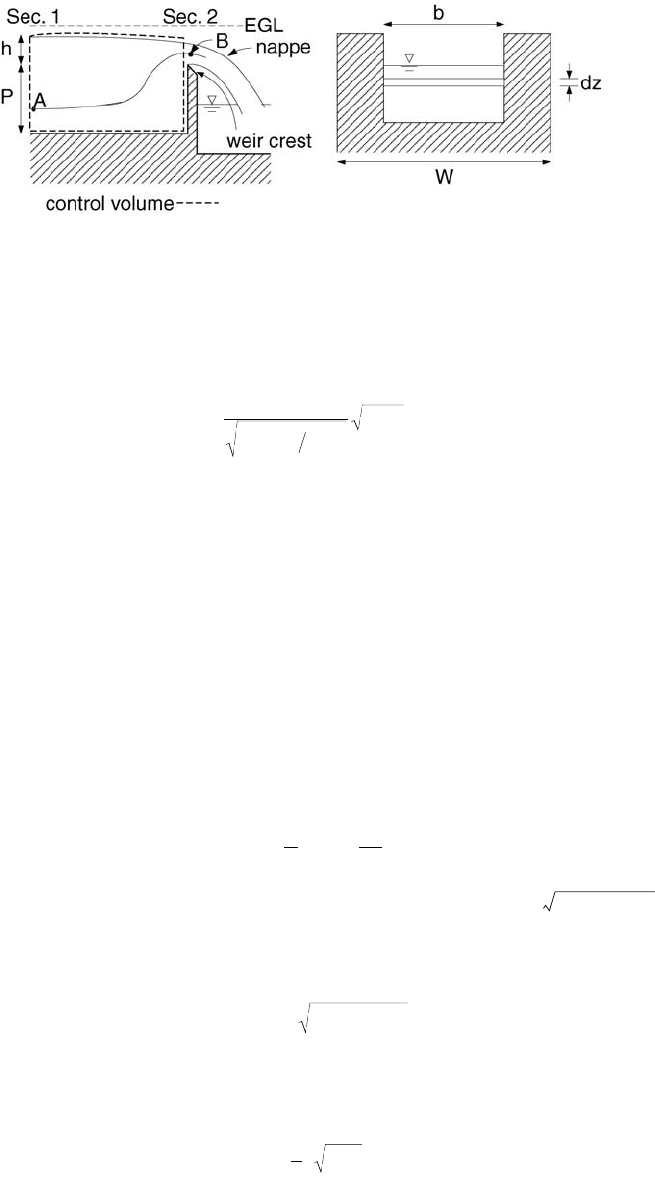
Fundamentals of Hydraulics 29-13
Thus, the flow rate, Q, can be directly related to the change in piezometric head, Dh, which can be
simply measured by means of piezometers (open tubes in which the flowing liquid can rise freely without
overflowing). The level to which the liquid rises in a piezometer coincides with the HGL since it is a free
surface. The discharge, Q, can therefore be expressed as
where the discharge coefficient, C
d
, is an empirical coefficient introduced to account for various approx-
imations in the analysis (see Section 29.9 for further discussion of C
d
for Venturi tubes).
Application 7: The Rectangular Sharp-Crested Weir
The sharp-crested weir (Fig. 29.12) is commonly used to measure discharges in open channels by a simple
measurement of water level upstream of the weir. It consists of a thin plate at the end of an open channel
over which the flow discharges freely into the atmosphere. The crest of the weir is the top of the plate.
The jet flow or nappe just beyond the crest should be completely aerated, i.e., at atmospheric pressure.
The discharge, Q, is to be related to the weir head, h, the elevation of the upstream free surface above
the weir crest. With the control volume as shown, mass conservation implies Q = V
1
A
1
= V
2
A
2
. Sec. 1
is chosen so that the flow is nearly parallel, and hence hydrostatic conditions prevail. As such, the
piezometric head at Sec. 1 is constant, [(p/g) + z] = h + P, with the channel bottom as datum. The
Bernoulli equation is applied on the streamline shown between points A and B at Sec. 1 and at Sec. 2,
with the result that
For an aerated nappe, p ª 0 at any point at Sec. 2, from which is obtained u
B
= . The
similarity between this and the result on orifice flow should be noted. The discharge is obtained, with
the further assumption that the velocity is constant across the weir crest, as
The upper limit of integration assumes that there is no drawdown at the weir, i.e., no depression of the
free surface below the undisturbed upstream level. The final result is that
where a discharge coefficient, C
d
, has been introduced to account for any approximations that have been made.
FIGURE 29.12 Flow over a sharp-crested rectangular weir.
Q
CA
AA
gh
d
=
-
()
out
out in
1
2
2
D ,
hP
p
z
u
g
+= +
Ê
Ë
Á
ˆ
¯
˜
+
g
B
B
2
2
2gh P z–+()
QuzdA ghPzbdz
B
SP
hP
=
()
=+-
()()
ÚÚ
+
2
QC b gh
d
=
Ê
Ë
Á
ˆ
¯
˜
2
3
2
3
© 2003 by CRC Press LLC
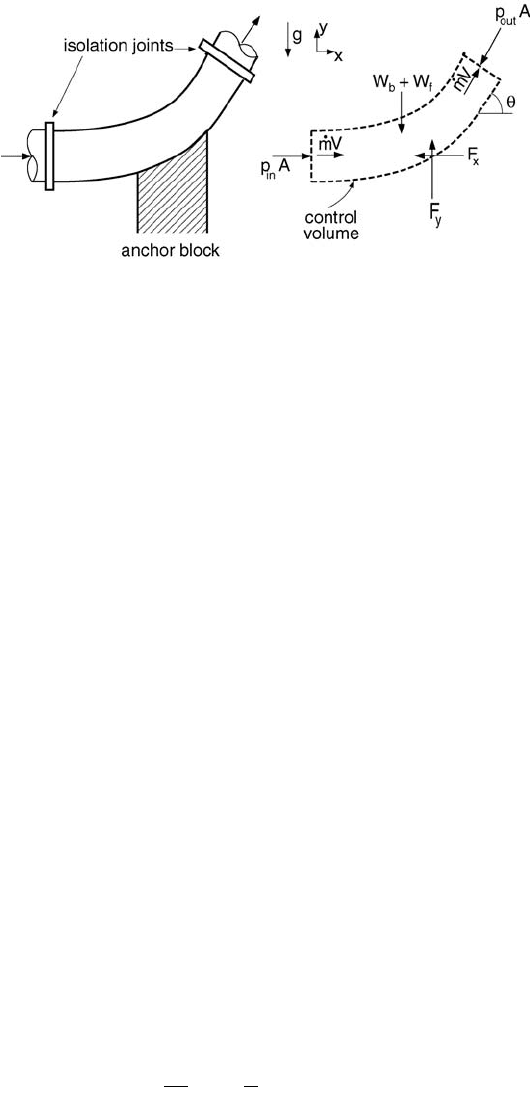
29-14 The Civil Engineering Handbook, Second Edition
A more complete discussion of C
d
for weirs is given in Section 29.9. The ‘weir’ discharge relation,
Q µ bh
3/2
, also arises in other applications, such as flows over spillways or other structures..
Application 8: Forces On a Pipe Bend Anchor Block
A vertical pipe bend is to be anchored by a block (Fig. 29.13). The average pressures at the inlet and outlet
are p
in
and p
out
, the steady discharge is Q = VA, and the pipe cross-sectional area is A. The weight of the
bend is W
bend
, and the weight of the fluid in the bend is W
f
. The entire load is assumed to be carried by
the anchor block, and so a control volume is considered as shown with force components on the pipe
bend due to the anchor block, F
x
and F
y
. The coordinate system is chosen so that velocities and forces are
positive upwards or to the right. The velocity vectors are V
in
= (V,0), and V
out
= (V cos q, V sin q), and the
pressure force at the inlet is (p
in
A, 0), and at the outlet, (–p
out
A cos q, –p
out
A sin q). The signs in the latter
are negative because the compressive pressure force components act in the negative x- and y-directions.
With b
in
ª b
out
ª 1, the two components of the momentum conservation equation can be written as:
Here, the signs of F
x
and F
y
follow from the (arbitrarily) assumed directions shown in Fig. 29.13; as
in elementary statics problems, if the solution for F
x
or F
y
is found to be negative, then the originally
assumed direction of the relevant force is incorrect. If the other quantities are known, then the forces,
F
x
and F
y
, can be computed. The forces on the block due to the pipe must be equal in magnitude and
opposite in direction.
Application 9: Energy Equation in a Pipe System with Pump
Fluid is pumped from a large pressurized tank or reservoir at pressure, p
in
, through a pipe of uniform
diameter discharging into the atmosphere (Fig. 29.14). The difference in elevation between the fluid level
in the tank and the pipe end is H. If the head loss in the pipe is known to be h
L
, and the head delivered
by the pump is H
p
, what is the discharge, Q? Equation (29.18b) is applied to the control volume with
inlet and outlet as shown and yields:
where the velocity head in the tank has been neglected, and the pressure at the outlet is zero because the
pipe discharges into the atmosphere. The discharge is calculated as Q = VA, where A is the pipe cross-
sectional area.
FIGURE 29.13 Forces on an anchor block supporting a pipe bend.
˙
cos cos
˙
sin sin
mV V p A p A F x
mV p A F W W y
x
yf
qq
qq
-
()
=- -
()
-
()
=- + - -
()
in out
out bend
-momentum
-momentum00
a
g
V
g
p
HhH
pL
2
2
Ê
Ë
Á
ˆ
¯
˜
=
Ê
Ë
Á
ˆ
¯
˜
+--
out
in
,
© 2003 by CRC Press LLC

Fundamentals of Hydraulics 29-15
The EGL (solid line) and HGL (dashed line) begin at a level p
in
/g above the liquid level in the tank
because the tank is pressurized, and coincide because the velocity head in the tank is negligible. In the
pipe flow region, they both slope downward in the direction of flow, the HGL always running parallel
but below the EGL, because the constant pipe diameter implies a constant difference due to the constant
velocity head. At the pump, energy is added to the system, so both the EGL and the HGL rise abruptly,
with the magnitude of the rise equaling the head delivered by the pump, H
p
. For a smaller pipe diameter
(say from the pump to the outlet), the vertical distance between the EGL and the HGL will be larger,
due to the larger velocity head, and for the same pipe material, the slope of the grade lines will be larger
because the friction slope, S
f
, increases with velocity. At the outlet, the HGL intersects the pipe centerline
because the pressure head there is zero (discharge into the atmosphere).
29.6 Dimensional Analysis and Similitude
Analysis based purely on conservation equations (including the Bernoulli theorem) is generally not
sufficient for the solution of engineering problems. It must be complemented by empirical correlations
or results from scale model tests. Dimensional analysis guides the organization of empirical data and the
design of scale models.
The Buckingham-Pi Theorem and Dimensionless Groups
Dimensions are associated with basic physical quantities, as distinct from units which are conventional
measures of physical quantities. In hydraulics, the basic dimensions are those of mass [M], length [L], and
time, [T], though that of force [F] may sometimes be more conveniently substituted for [M]. In this section,
square brackets indicate dimensions. A physically sound equation describing a physical phenomenon must
be dimensionally homogeneous in that all terms in the equation must have the same dimensions. The basic
theoretical result is the Buckingham-Pi theorem, which states that, for a problem involving N independent
physical variables and M basic dimensions, N – M independent dimensionless groups (of variables) can be
formed. The design of empirical correlations and scale models needs therefore consider only the N – M
dimensionless groups rather than the original N variables in order to describe completely the flow phe-
nomena. Further, a relationship among the dimensionless groups relevant to a problem is automatically
dimensionally homogeneous, and as such satisfies a requirement for a physically sound description.
The two most useful dimensionless groups in hydraulics are the Reynolds number, Re rUL/m, and
the Froude number, Fr U/, where U and L are velocity and length scales characteristic of a given
problem. The former is interpreted as measuring the relative importance of inertial forces (ma ~ rU
2
L
2
)
FIGURE 29.14 Energy analysis and associated hydraulic and energy grade lines of a pipe-pump system.
in
p
in
H
pump
out
HGL
EGL
HGL
EGL
H
p
γ
p /
in
gL
© 2003 by CRC Press LLC
29-16 The Civil Engineering Handbook, Second Edition
to viscous forces (tA ~ m(U/L)L
2
), where m is a mass, a an acceleration, t a shear stress, and A an area
on which the shear stress acts. At sufficiently high Re (for pipe flows, Re = rVD/m ª 2000, where D is
the pipe diameter, for open-channel flows, Re = rVD/m ª 500, where h is a flow depth), flows become
turbulent. Similarly, for given boundary geometry, high Re flows are more likely than low Re flows to
separate. The Froude number may be similarly interpreted as measuring the relative importance of inertial
to gravitational forces (~rgL
3
). It plays an essential role in flow phenomena involving a free surface in a
gravitational field, and is discussed at length in the section on open channel flows.
An argument that can often be applied arises in the asymptotic case where a dimensionless group
becomes very large or very small, such that the effect of this group can be neglected. An example of this
argument is that used in the case of high Re flows, where flow characteristics become essentially inde-
pendent of Re (see the discussion in Section 29.7 of the Moody diagram).
Similitude and Hydraulic Modelling
Similitude between hydraulic scale model and prototype is required if predictions based on the former
are to be applicable to the latter. Three levels of similarity are geometric, kinematic, and dynamic, and
follow from the basic dimensions. Geometric similarity implies that all length scale ratios in both model
and prototype are the same. Kinematic similarity requires, in addition to geometric similarity, that all
time scale ratios be the same. This implies that streamline patterns in model and prototype must be
geometrically similar. Finally, dynamic similarity requires, in addition to kinematic similarity, that all
mass or force scale ratios be the same. This implies that all force scale ratios at corresponding points in
model and prototype flows must be the same. Equivalently, similitude requires that all but one relevant
independent dimensionless groups be the same in model and prototype flows. Typically, dynamic sim-
ilarity is formulated in terms of dimensionless groups representing force ratios, e.g., Re
p
= Re
m
, or Fr
p
=
Fr
m
, where the subscripts, p and m, refer to prototype and model quantities respectively.
Practical hydraulic scale modeling is complicated because strict similitude is generally not feasible, and
it must be decided which dimensionless groups can be neglected, with the possible need to correct results
a posteriori. In many hydraulic models involving open-channel flows, the effects of Re are neglected,
based on an implicit assumption of high Re similarity, and only Fr scaling is satisfied, since it is argued
that free-surface gravitational effects are more important than viscous effects. Flow resistance, which may
still be dependent on viscous effects, may therefore be incorrectly modeled, and so empirical corrections
to the model results for flow resistance may be necessary before they can be applied to the prototype
situation. Similarly, geometric similarity is often not achieved in large-scale models of river sytems or
tidal basins, because this would imply excessively small flow depths, with extraneous viscous and surface-
tension effects playing an erroneously important role. Distorted modeling with different vertical and
horizontal length scales is therefore often applied. These deviations from strict similitude are discussed
in more detail in Yalin (1971) and Sharpe (1981) specifically for problems arising in hydraulic modeling.
Application 10: Pump Performance Parameters
The power required by a pump,
•
W
p
[ML
2
/T
3
], varies with the impeller diameter, D [L], the pump rotation
speed, n [1/T], the discharge, Q [L
3
/T], and the fluid density, r [M/L
3
]. How can this relationship be expressed
in terms of dimensionless groups? It follows from the Buckingham-Pi theorem that only two independent
dimensionless groups may be formed since five variables (
•
W
p
, D, n, Q, and r) and three dimensions ([M],
[L], [T]) are involved. The dimensionless groups are not unique, and different groups may be appropriate
for different problems. Three basic variables involving the basic dimensions are chosen, e.g., n, D, and r.
Mass (m), length (l), and time (t) scales are formed from these basic variables, e.g., rD
3
, l = D, t = 1/n. The
remaining variables are then made dimensionless by these scales, e.g.,
•
W/(ml
2
/t
3
)=
•
W/[(rD
3
)D
2
n
3
], and
Q/(l
3
/t) = Q/(nD
3
). These are the power and the flow-rate (or discharge) coefficients respectively of a pump.
A relationship between these dimensionless groups can be written as
•
W/[(rD
3
)D
2
n
3
] = F [Q/(nD
3
)] which
can be used to characterize the performance of a series of similar pumps.
© 2003 by CRC Press LLC
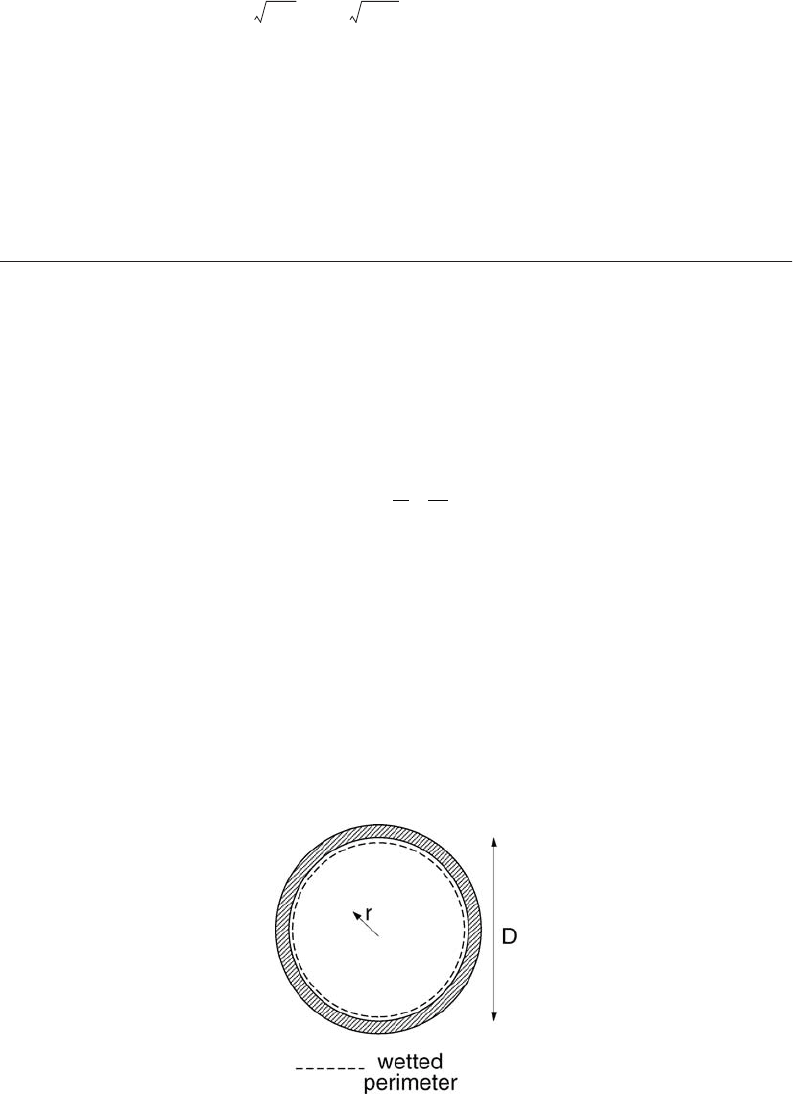
Fundamentals of Hydraulics 29-17
Application 11: Spillway model
A dam spillway is to be modeled in the laboratory. Strict similitude requires Re
p
= Re
m
and Fr
p
= Fr
m
, or,
r
p
U
p
L
p
/m
p
= r
m
U
m
L
m
/m
m
and U
p
/ = U
m
/. For practical purposes, g
p
= g
m
, which implies that
(m
m
/r
m
)/(m
p
/r
p
) = (L
m
/L
p
)
3/2
. For practical scale ratios, this restriction is not feasible because no common
fluid has such a small n
m
= (m
m
/r
m
). The test is therefore conducted using Froude scaling, Fr
p
= Fr
m
, with
the only condition on Re
m
being that it must be sufficiently high (say Re
m
> 5000) such that the flow is
turbulent and Reynolds number effects can be assumed negligible. Fr
m
= Fr
p
requires that U
m
/U
p
=
(L
m
/L
p
)
1/2
, which in turn implies that Q
m
/Q
p
=(U
m
L
2
m
)/(U
p
L
2
p
)= (L
m
/L
p
)
5/2
. Thus, if Q
m
is measured in the
scale model, then the corresponding discharge in the prototype is expected to be Q
p
= Q
m
(L
p
/L
m
)
5/2
.
29.7 Velocity Profiles and Flow Resistance in Pipes
and Open Channels
Flow Resistance in Fully Developed Flows
A fully developed steady flow in a conduit (pipe or open channel) is defined as a flow in which velocity
characteristics do not change in the streamwise direction. This occurs in straight pipe or channel sections
of constant geometry far from any transitions such as entrances or exits. Under these conditions, appli-
cation of momentum and energy conservation equations yields a balance between shear forces on the
conduit boundary and gravitational and/or pressure forces, or
(29.19)
where t
w
is the average shear stress on the conduit boundary, A is the cross-sectional flow area, P is the
wetted perimeter, h
f
is the head loss due to boundary friction over a conduit section of length, L. The
wetted perimeter is the length of perimeter of the conduit which is in contact with the fluid; for a circular
pipe flowing full (Fig. 29.15), the wetted perimeter is the pipe circumference, or P = pD.
Equation (29.18) is also frequently written as
t
w
=
g
R
h
S
f
, where R
h
A/P is called the hydraulic radius,
and S
f
= h
f
/L, the energy or friction slope. For a circular pipe flowing full, R
h
= A/P = D/4. A shear
velocity, u
*
, can be defined such that u
2
*
= t
w
/r, from which it follows that
(29.20)
FIGURE 29.15 Coordinate system for pipe flow velocity profile, and the wetted perimeter for a pipe flowing full.
g
p
L
p
g
m
L
m
tg
w
f
A
P
h
L
=
Ê
Ë
Á
ˆ
¯
˜
Ê
Ë
Á
ˆ
¯
˜
ugRS
hf*
2
=
© 2003 by CRC Press LLC
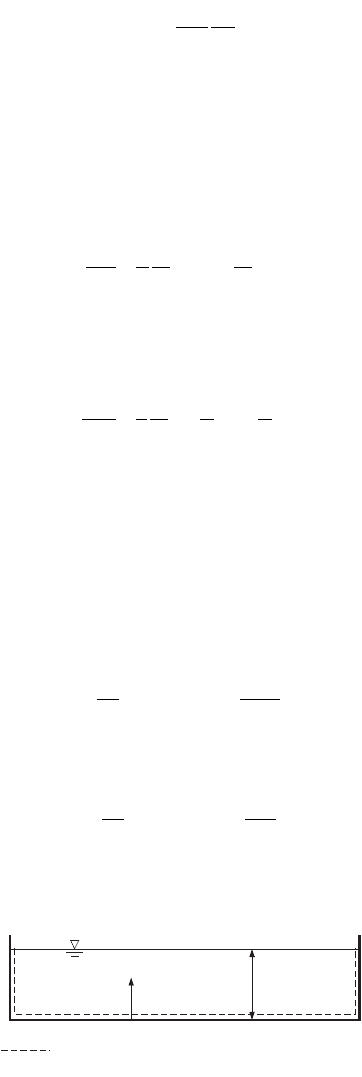
29-18 The Civil Engineering Handbook, Second Edition
These expressions hold for both laminar and turbulent flows. The frictional head loss, h
f
, increases
linearly with the length, L, of the conduit, and so may be conveniently expressed in terms of the Darcy-
Weisbach friction factor, f, as
(29.21)
or (u
*
/V)
2
= f/8.
Laminar Velocity Profiles
Velocity profiles for steady fully developed laminar flows in a circular pipe and in an infinitely wide open
channel can be theoretically obtained. For a circular pipe, it can be shown that
(29.22)
where u(r) is the point velocity at a radial distance, r, measured from the centerline (Fig. 29.15), and the
pipe Reynolds number, Re = rVD/m. For an infinitely wide open channel,
(29.23)
where u(y) is the velocity at a vertical distance y measured from the channel bottom (Fig. 29.16), h the
flow depth, and the channel Reynolds number, Re = V (4R
h
)/n. Note that R
h
= h for an infinitely wide
channel. Both profiles exhibit a quadratic dependence on r or y.
Friction Relationships for Laminar Flows
A simple relation between f and Re can be obtained by integrating Eqs. (29.21) or (29.22) over the cross
section of the flow. For a circular pipe,
(29.24)
while for an infinitely wide channel,
(29.25)
where the appropriate definition of the Reynolds number must be used.
FIGURE 29.16 Coordinate system for open-channel flow velocity profile, and the corresponding wetted perimeter.
hf
L
R
V
g
f
h
=
42
2
ur
u
u
V
Re
r
D
()
*
*
=-
Ê
Ë
Á
ˆ
¯
˜
È
Î
Í
Í
˘
˚
˙
˙
1
4
1
2
2
uy
u
u
V
Re
y
h
y
h
()
*
*
=
Ê
Ë
Á
ˆ
¯
˜
-
Ê
Ë
Á
ˆ
¯
˜
1
8
2
fh
L
gD
V
f
==
64 32
2
Re
and
n
fh
L
gh
V
f
==
96 3
2
Re
and
n
wetted
perimeter
y
h
© 2003 by CRC Press LLC

Fundamentals of Hydraulics 29-19
Turbulent Velocity Profiles
Because a complete theory for turbulent pipe or channel flows is lacking, a greater reliance on empirical
results is necessary in discussing turbulent velocity profiles. Two types of profiles are the log-law profile
and the power-law profile. The log-law profile is more physically sound, but a detailed discussion becomes
complicated. A useful approximate form may be given as
(29.26)
where x is the coordinate measured from the wall, k ª 0.4 is the von Kármán constant, D is the depth
in the case of open-channel flow, and the radius in the case of pipe flow, and B is a constant with value
ª2.5 for flow in a wide open channel, and ª3.7 for pipe flows. This profile is not valid very near the
boundary (x Æ 0). Near the centerline or free surface, (x Æ D), it also deviates from observations, though
for practical purposes, the deviation can generally be considered negligible in pipes and channels. In
some problems, the power-law profile may be more convenient; it is expressed as
(29.27)
where u
max
is the maximum velocity attained in the flow (at x = D), and m increases slowly with increasing
Re from m = 6 at Re = 5000 to m = 10 for Re > 2 ¥ 10
6
. In real open-channel flows, the maximum velocity
may not occur at the free surface due to the effects of secondary currents, and Eq. (29.27) must be
accordingly interpreted.
Effects of Roughness
The effects of the small-scale roughness of solid boundaries on flow resistance are negligible for laminar
flows, but become important for turbulent flows. Wall roughness for a given conduit material is charac-
terized by a typical roughness height, k
s
, of roughness elements. The wall is said to be hydrodynamically
smooth if k
s
< d
n
, where the thickness of the viscous sublayer, d
n
ª 5n/u
*
. Similarly, the wall is said to be
fully rough if k
s
d
n
. Precise information regarding k
s
is usually available only for new pipes, and with age,
k
s
is likely to increase. For natural open-channel flows, such as in rivers, a roughness height may also be
used to characterize flow resistance, though the wide variety of roughness elements makes difficult a precise
practical definition of k
s
. A range of values of k
s
is given on the Moody diagram at the end of this chapter.
Friction Relationships for Turbulent Flows in Conduits
The turbulent velocity profiles can be integrated to give friction relationships for steady fully developed
turbulent flows. The well-known Colebrook-White formula,
(29.28)
is based on a log-law profile. Given Re and k
s
/D, then f can be determined. This formula is implicit and
transcendental for f, and its graphical form (the Moody diagram, Fig. 29.22, at the end of this chapter)
is useful for understanding the qualitative behavior of f in response to changes in Re and k
s
/D. On log-
log coordinates, curves of f vs Re at constant k
s
/D are plotted. To the left of the Moody diagram, the
laminar-flow solution for f (Eq. [29.24]) appears as a straight line of slope –1 (since f µ Re
–1
) for Re <
2000. For given k
s
/D, the curves of f vs Re become horizontal for sufficiently high Re, which is an example
of the high Re similarity mentioned in Section 29.6. In this ‘fully rough’ regime, f is practically independent
of Re and depends only on k
s
/D, such that for given k
s
/D, the head loss, h
f
µ Q
2
, or h
f
µ V
2
(or h
f
µ S
f
1/2
)
which is characteristic of high Re turbulent flows, and contrasts with laminar flows (see Eqs. 29.24 through
u
u
V
u
B
x
k
x
()
=+ +
**
ln
1
D
u
u
m
x
x
()
=
Ê
Ë
Á
ˆ
¯
˜
max
/
D
1
1
086
37
251
f
k
D
Re f
s
=- +
Ê
Ë
Á
ˆ
¯
˜
.ln
.
.
© 2003 by CRC Press LLC
